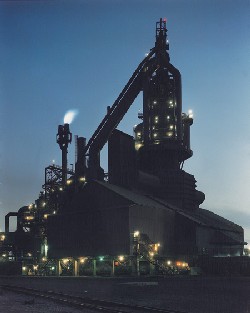| Maryland Newsline |
| Home Page |
Politics
|
| Maryland's Industrial Air Pollution Falls Slightly, Future Gains
May Be Elusive
Capital News Service Sunday, April 29, 2001
WASHINGTON - The amount of air pollution emitted by all facilities reporting annually in Maryland fell slightly in the latter half of the 1990s, according to an analysis of four years of state emissions certification reports. That continues a long-term reduction in air pollution that began in the 1970s, but the rate of decline in recent years has slowed substantially, according to a senior state environmental official, who said that additional reductions will be harder to achieve. "If you look at pollutant levels from 1970 to 1980 to 1990 and then to 2000, you'd see a pretty steep drop," said Angelo Bianca, deputy director of the Department of the Environment's Air and Radiation Management Administration. "But the closer to 2000, the drop starts to level out, because it's harder to get those last few tons of emissions reductions." Bianca said the task becomes even more difficult as increasing numbers of automobile and consumer products begin to account for a larger share of some pollutants. But some environmentalists are unhappy with the government's efforts to reduce air pollution--so unhappy that they are suing both the U.S. Environmental Protection Agency and some states, including Maryland, for what they say is a failure to enforce the Clean Air Act. "I think there are a lot of things that could have been done to improve it [air quality] that haven't been done," said Jon Robinson, head of the Maryland chapter of the Sierra Club. "They are required to reduce certain pollutants on a certain time scale and have a plan to do so, and they haven't done that," said Robinson. He added that there are summer days in his Prince George's County neighborhood, "particularly on the weekends, when it is painful to breathe." Overall pollution is dropping A Capital News Service analysis of Maryland Department of the Environment annual emissions certification data shows that total air pollution from six measured categories fell by 20,000 tons, or 3.3 percent, to just under 600,000 tons between 1996 and 1999. The numbers are based on certified emissions data from about 500 facilities that are required to report to the state. While yearly changes varied from a 4.5 percent gain in 1996-1997 to a 7.3 percent drop in 1998-1999, the average annual change showed a drop of about 1 percent or 6,700 tons of air pollution from the reporting facilities. That includes emissions from all major power plants, industrial manufacturers and other stationary sources regulated by the federal government through the state, which runs both its own and the federal emissions permit program. Stationary sources include "point" sources, chiefly smokestacks, and "area" sources, which can include anything from gas stations to dry cleaners to an assortment of consumer and cosmetic products. "You can always squeeze more pollution out of a source, but it gets to be more difficult and more expensive due to technological limitations," Bianca said. Of the six categories of pollutants, four are directly regulated under the federal Clean Air Act. These so-called "criteria pollutants" include sulfur dioxide, nitrogen oxides, carbon monoxide and particulate matter, referred to often as just particulates. The remaining two categories include volatile organic compounds and a series of 10 compounds called hazardous air pollutants. There are actually many hazardous air pollutant compounds, but chief among the state's narrow list are cyanide compounds and hydrogen chloride. Both sulfur dioxide and nitrogen oxides result from power plant emissions, automobile emissions and industrial operations. Carbon monoxide chiefly comes from cars and to a lesser extent industrial operations. Particulate matter includes dust, ash, smoke and fumes--as generated by incinerators, industrial operations and agricultural tilling. Volatile organic compounds are emitted by gasoline, paints, inks and solvents. Ozone is major remaining problem Ozone, another criteria pollutant, is not specifically included in the six categories of emissions certification data because it is not emitted directly by any source. Rather, nitrogen oxides react with volatile organic compounds in sunlight to form ozone. Bianca said the only major air quality problem left in Maryland is ozone pollution. "Long term, the state has made good progress," Bianca said. "Our only remaining problem, if you look at it from a federal standard...is ground- level ozone." Terry Harris, chairman of the Cleanup Coalition, agrees that major progress has been made over the past 30 years, but he said big problems remain. "We are making progress, but it is still a huge concern," said Harris, whose small nonprofit helps community groups decide whether to contest state permits for industrial air emissions and water discharge. "What with asthma rates what they are and respiratory diseases." Harris said state environmental groups are focusing on reducing fossil fuel consumption through transportation policy and energy efficiency, because they recognize that such mobile sources are major sources of pollution. Nevertheless, he said industries must "do their share" because of their pollution emissions, both the criteria pollutants and toxic metals like lead and mercury. "Industry is a small part of the [overall] problem, but they need to do their share," Harris said. "While some industries have made a lot of progress, others still have room for improvement." Copyright © 2001 University of Maryland College of Journalism
|

